Think you don’t have room for houseplants? Think again! Even the tiniest spaces can come to life with the right greenery. These compact houseplants are perfect for small spaces. Baby Rubber Plant care is easy and rewarding for all.
Learning how to care for a baby rubber plant is simpler than you think. Native to South America, Baby Rubber Plants belong to the Piperaceae family. They are known for their attractive foliage and low-maintenance needs. This guide will cover everything you need to know about caring for your Baby Rubber Plant.
Baby Rubber Plants are perfect for desks, shelves, or any small space. By understanding the basics of rubber plant care, you can enjoy many benefits. From air purification to stress reduction, the advantages of having a Baby Rubber Plant are numerous. So why not give it a try and start enjoying the rewards of Baby Rubber Plant care today?
Key Takeaways
- Baby Rubber Plants are native to South America and belong to the Piperaceae family.
- They are known for their compact size and low-maintenance requirements, making them perfect for small spaces.
- Proper Baby Rubber Plant care includes providing the right amount of light, water, and nutrients.
- With proper care, Baby Rubber Plants can live indoors for 5-6 years and grow up to 20 inches tall.
- They are non-toxic and safe to have around pets, making them a great choice for families.
- By following the right guidelines for Baby Rubber Plant care, you can keep your plant happy and thriving.
- Baby Rubber Plant care is easy and rewarding, making it perfect for beginners and experienced plant enthusiasts alike.
Introduction to the Baby Rubber Plant
Exploring houseplants, you’ll find the Baby Rubber Plant unique. It stores water in its leaves, making it good at handling dry spells. Remember, it likes soil that drains well to avoid root rot.
This plant loves bright, indirect light. It’s perfect for rooms with east- or west-facing windows. Knowing its light needs helps it grow well.
What Makes Baby Rubber Plants Unique?
Baby Rubber Plants come from Central and South America. They’ve been popular houseplants since the 1930s. They’re small, growing 0.5 to 1 feet tall and spreading 1 to 2 feet wide. Here are some key features:
- Height: 0.5 to 1 feet
- Spread: 1 to 2 feet
- USDA hardiness zones: 10 through 11
- Light requirement: partial to deep shade
Benefits of Having a Baby Rubber Plant in Your Home
Baby Rubber Plants are safe for pets and kids. They also fight off most pests, making them easy to care for. With the right care, like watering and light, they bring joy to your home.
Ideal Growing Conditions
To keep your Baby Rubber Plant happy, give it the right growing conditions. Use soil that drains well and has peat moss, perlite, and orchid bark. Prune it right to help it grow healthy and avoid damage.
Baby Rubber Plants like bright, indirect light but can handle lower light too. They do best in temperatures between 60°F-75°F, perfect for indoors. They like humidity levels of 50-60% but can adjust to indoor levels.
Light Requirements
Baby Rubber Plants do well in different lights. They love bright, indirect light. This is great for rooms with east- or west-facing windows.
Temperature Preferences
They prefer temperatures between 60°F-75°F. This makes them perfect for indoor spaces, as they thrive in average room temperatures.
Humidity Levels
They like humidity levels of 50-60%. But they can also handle average indoor humidity. This is good for rooms like living rooms or bedrooms.
By giving your Baby Rubber Plant the right conditions, it will thrive. Use the right soil and prune it correctly. This way, you’ll enjoy its beautiful leaves for years.
| Condition | Preferred Level |
|---|---|
| Light | Bright, indirect light |
| Temperature | 60°F-75°F |
| Humidity | 50-60% |
Watering Your Baby Rubber Plant
Watering your baby rubber plant right is key. Too much water can hurt the roots. Too little can make the leaves dry out. Check the soil often and water when it’s dry about 2 inches down.
The light and temperature where your plant sits matter too. Brighter spots need more water. Cooler spots need less. Repotting baby rubber plant means it might need more water at first.
Here are some tips for watering:
* Water every 7-10 days, depending on soil moisture
* Allow the top 2 inches of soil to dry out before watering again
* Avoid getting water on the leaves to prevent rot
* Use room-temperature water to prevent shocking the roots
Proper watering is just part of caring for your plant. Baby rubber plant propagation also depends on humidity and temperature. Give your plant the right conditions and it will do well.
| Factor | Recommended Level |
|---|---|
| Watering Frequency | Every 7-10 days |
| Humidity | 40-50% |
| Temperature | 60-75°F |
Soil and Potting Needs
Choosing the right soil mix is key for caring for a baby rubber plant. Use a mix of peat moss, perlite, and orchid bark. This mix prevents water from staying too long at the roots, which helps avoid root rot.
To keep your baby rubber plant healthy, follow these tips:
- Use a pot that is slightly larger than the current one, with drainage holes to prevent waterlogging.
- Repot your baby rubber plant only when it becomes root-bound or outgrows its current container.
- Choose a soil mix that is light, slightly acidic, and rich in organic matter.
By following these tips, you can give your baby rubber plant the best chance to thrive. Remember, how to care for a baby rubber plant means paying close attention and creating the right environment. With the right soil and potting, your baby rubber plant will bring joy for years.
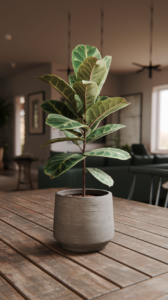
| Soil Mix | Benefits |
|---|---|
| Peat moss, perlite, and orchid bark | Prevents water from pooling at the roots, reducing the risk of root rot |
| Light, slightly acidic, and rich in organic matter | Provides the right conditions for the baby rubber plant to thrive |
Fertilizing Your Baby Rubber Plant
To help your Baby Rubber Plant grow well, you need to fertilize it. The best time to do this is in the spring and summer. Use a balanced, water-soluble fertilizer that’s half-strength. This kind of fertilizer is easy to find at gardening stores.
Fertilize your plant every 4-6 weeks during the growing season. Always follow the fertilizer’s instructions and dilute it to half-strength. This prevents harming your plant’s roots. After fertilizing, water your plant well to avoid fertilizer buildup. Regular pruning baby rubber plant helps its shape and encourages new growth. You can do this through baby rubber plant propagation methods.
- Avoid overfertilizing, as this can cause more harm than good
- Use a fertilizer that is specifically formulated for houseplants
- Follow the instructions on the fertilizer package carefully
By following these tips and fertilizing your Baby Rubber Plant regularly, you can help promote healthy growth and development. This will keep your plant thriving for years to come.
Pest Management
Managing pests is key when caring for a baby rubber plant. You’ll need to watch out for aphids, mealybugs, and spider mites. These pests can harm your plant’s leaves and stems.
To fight these pests, try using insecticidal soap and neem oil. These are safe for your plant and the environment. Checking your plant often can also help keep pests away.
Common Pests and How to Identify Them
- Aphids: small, soft-bodied insects that can be found on the underside of leaves
- Mealybugs: white, cottony insects that can be found on the stems and leaves
- Spider mites: tiny, spider-like insects that can cause yellowing or bronzing of the leaves
Natural Remedies for Pest Control
Other natural ways to fight pests include using beneficial insects like ladybugs. Also, having a variety of plants can help keep pests away. This can increase the number of good insects by 25%.
By following these tips, you can keep your baby rubber plant healthy. Always check your plant for pests and act fast if you find any. This will help your plant stay strong and beautiful.
| Pest | Identification | Natural Remedy |
|---|---|---|
| Aphids | Small, soft-bodied insects on underside of leaves | Insecticidal soap, neem oil |
| Mealybugs | White, cottony insects on stems and leaves | Insecticidal soap, neem oil |
| Spider mites | Yellowing or bronzing of leaves | Insecticidal soap, neem oil |
Pruning and Maintenance
Pruning and maintenance are key to keep your Baby Rubber Plant healthy. Pruning helps keep the plant’s shape and encourages new growth. Prune your Baby Rubber Plant from early spring to early summer. Remove about 25% of the plant’s size at a time.
Look for signs like leggy stems and yellowing leaves when pruning. Use sharp tools to avoid harming the plant. Don’t prune too much in winter when the plant is sleeping. After pruning, water your plant well but not too much. You can also use stem cuttings to grow new plants, a great way to practice baby rubber plant propagation.
Check your plant often to know when to prune. This is also a good time to repot baby rubber plant if it’s too big for its pot. By following these tips, your Baby Rubber Plant will stay healthy and strong.
Here are some important things to remember when pruning and caring for your Baby Rubber Plant:
- Prune during the active growth period, from early spring to early summer
- Remove approximately 25% of the plant’s size at a time
- Use sharp tools to avoid damaging the plant
- Water consistently but controlled after pruning
- Consider repotting if the plant has outgrown its container
Troubleshooting Common Issues
Learning to care for a baby rubber plant can lead to some common problems. These issues can affect its health and look. Yellowing leaves are a big problem, often caused by too much or too little water, or too much sun.
To fix yellow leaves, change how often you water it. Make sure it gets the right amount of light. Check the soil by sticking your finger in it. If it’s dry, water it. If it’s wet, wait a bit longer.
Causes of Dropping Leaves
Leaves dropping can happen due to changes in temperature or humidity, or pests. Check the plant’s environment and adjust as needed. Pruning can also help new growth and stop leaves from falling off.
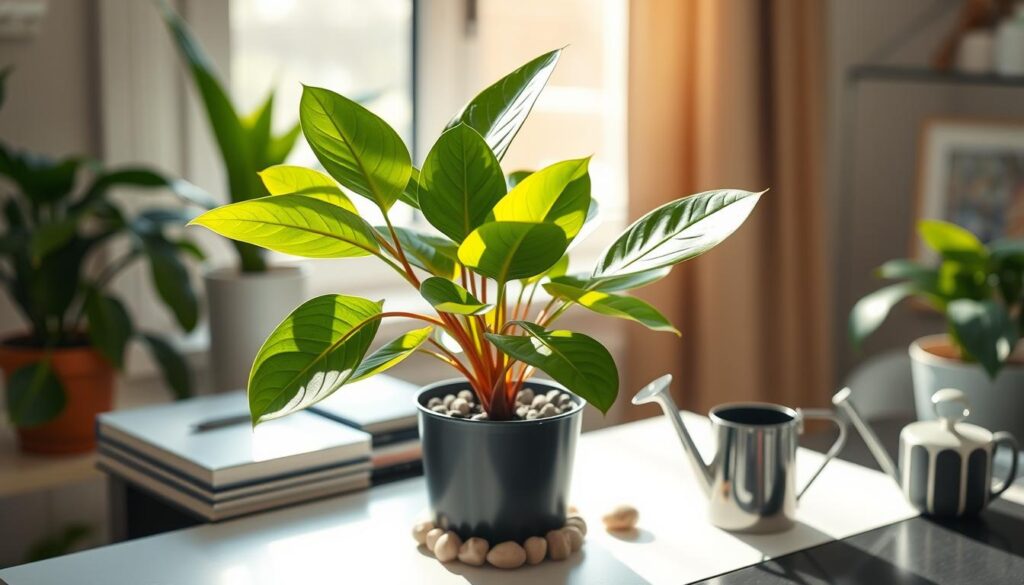
Other problems like curling leaves, brown leaves, and leaf drop can also occur. These might be from too much or too little water, or from extreme temperatures. Knowing the reasons and how to prevent them will help your plant stay healthy.
| Issue | Cause | Solution |
|---|---|---|
| Yellowing leaves | Overwatering, underwatering, or exposure to direct sunlight | Adjust watering schedule and provide indirect sunlight |
| Dropping leaves | Temperature fluctuations, humidity changes, or pest infestations | Adjust temperature, humidity, and pest control measures |
| Curling leaves | Overwatering or underwatering | Adjust watering schedule |
By following these tips, you can keep your baby rubber plant healthy. Always learn about your plant’s specific needs. And don’t be afraid to ask for help if you’re not sure.
Conclusion: Enjoying Your Baby Rubber Plant
With the right care, your Baby Rubber Plant will thrive. It will bring joy to your home for years. Follow the tips in this article to keep your plant healthy and beautiful.
Final Tips for Thriving Growth
Check your plant’s water often. Make sure it gets the right sunlight. Also, use the best soil for it.
Watch for pests or diseases. This way, you can fix problems fast. You can also join a plant group or talk to a local nursery for help.
Resources for Further Learning
Want to learn more about your Baby Rubber Plant? There are many online resources and books. They can teach you a lot and make you a better plant parent.


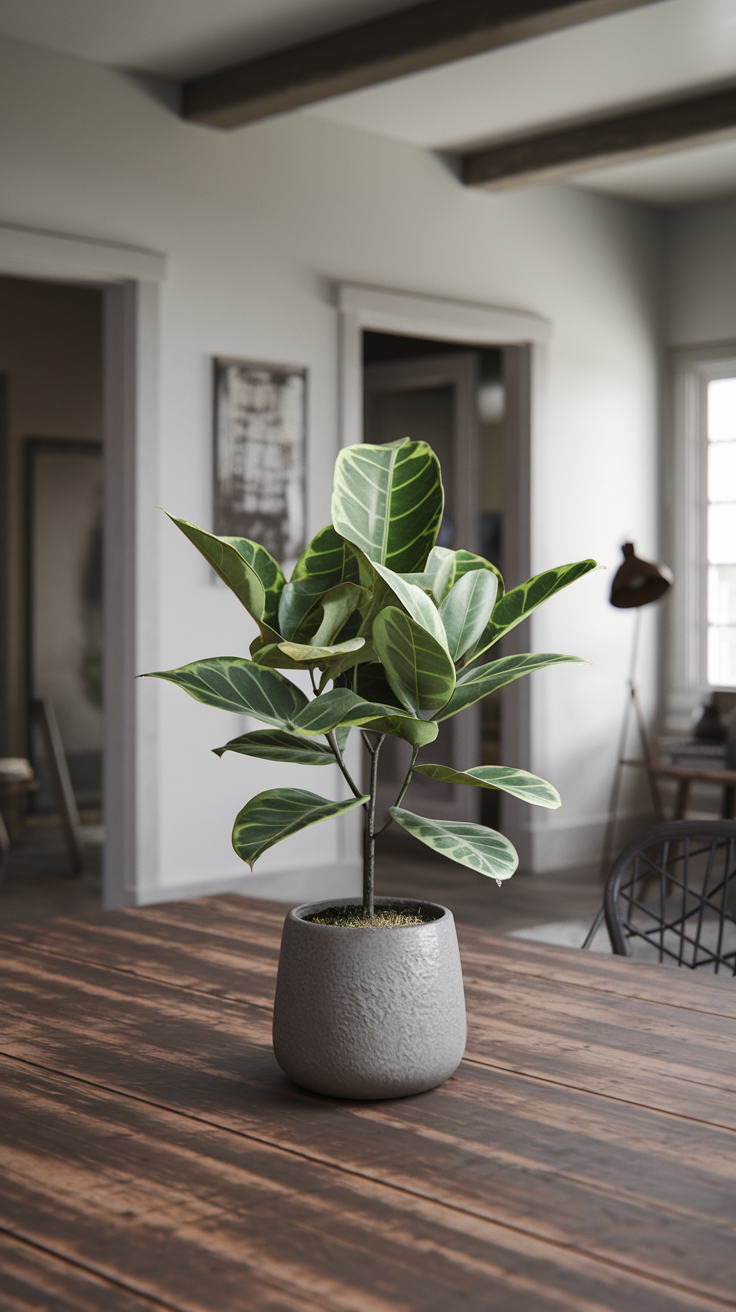
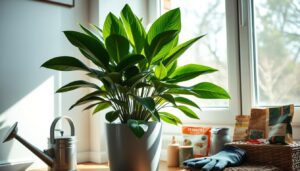

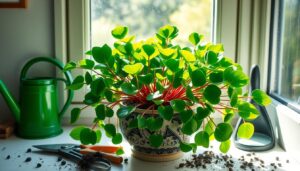
Pingback: The Ultimate Guide to Houseplants: 100 Best Indoor Plants for Every Home - Trusted House Plant Guide